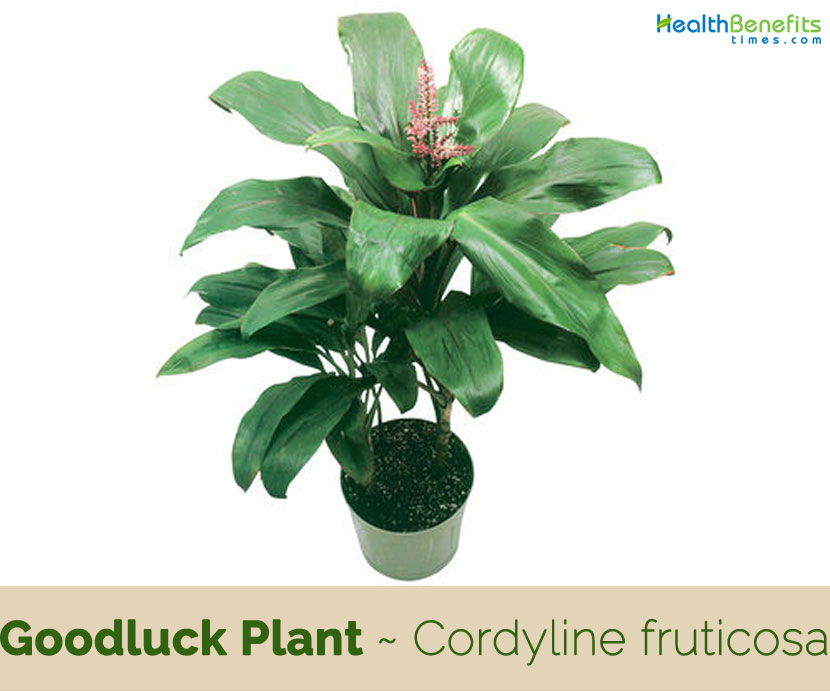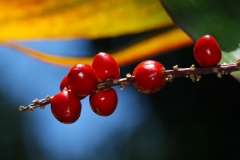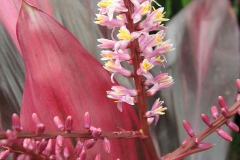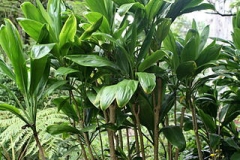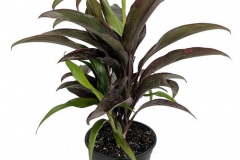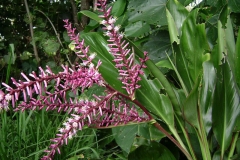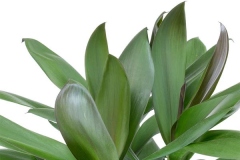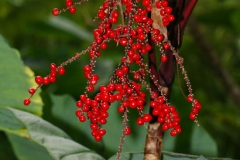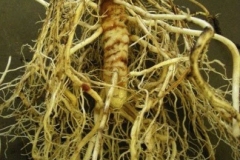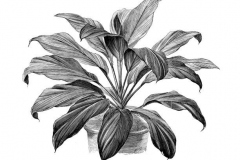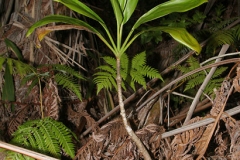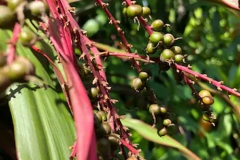| Goodluck Plant Quick Facts | |
|---|---|
| Name: | Goodluck Plant |
| Scientific Name: | Cordyline fruticosa |
| Origin | Southeast Asia and Papua New Guinea, but was carried throughout much of the Pacific by early Polynesians |
| Colors | initially yellow, turning to bright red as they mature |
| Shapes | Round, three-parted, 1 cm diameter berries, several to many seeded |
| Health benefits | Anti-Inflammatory, Infectious conditions, Curing Hemorrhoids, Treat Bloody Urine, Treating Dysentery, Menstruating, Anti-Cancer, Relieve Asthma Symptoms, Overcoming a Bloody Cough, Alleviate Ulcer Symptoms |
| Height | 3-10 feet |
| Spread | 2-4 feet |
| Plant Habit | Upright |
| Plant Density | Open |
| Growth Rate | Moderate |
| Texture | Medium |
Leaves
| Leaf arrangement | Spiral |
| Leaf Type | Simple |
| Leaf Margin | Entire |
| Leaf Shape | Linear |
| Leaf Venation | Parallel |
| Leaf type and Persistence | Evergreen |
| Leaf blade Length | 8-12 inches, 12-18 inches, variable |
| Leaf Color | Purple or red, green |
| Fall Color | No fall color change |
| Fall Characteristics | Not Showy |
Flower
| Flower Color | Yellow |
| Flower Characteristics | Spring Flowering |
Fruit
| Fruit Shape | Round |
| Fruit Length | Less than .5 inch |
| Fruit Cover | Fleshy |
| Fruit Color | Red |
| Fruit Characteristics | Inconspicuous and not showy |
Health benefits of Good luck Plant
Listed below are some of the popular health benefits of Good luck plant
1. Anti-Inflammatory
One of the most common benefits from Goodluck Plant is its capability as an anti-inflammation or swelling of the gums. You can apply the ti plant leaf by smoothing the leaves and, mix with a little salt and apply on the swollen gums. Your gums will quickly heal and minimize the pain.
2. Infectious conditions
Juice expressed from the leaf after heating it is the remedy for sores and pimples of the Tok Sisin tribe in Papua New Guinea. Fijian makes use of this juice to treat earache, sore eyes and eczema. Roots cure toothache and laryngitis while the outer rind of the flower stalk is used in the treatment of syphilis.
3. Curing Hemorrhoids
Hemorrhoids usually occur in people who drink less, less of physical activity, and sit too much, and didn’t consume sufficient fiber. The disease can be recognized by the presence of a mixture of blood stains on the feces (fese) when you defecate. When it gets worse, it will be very disturbing because you will have difficulty to sitting, anemia (lack of blood) and many others. To use Ti Plant as for treat Hemorrhoids, you simply combine 7 pieces of purple leaves and 3 sheets of Ti Plant leaves. Wash and crushed both then boiled with 3 cups of water until it remaining 2 cups. Drinking routinely 2 times a day until the hemorrhoids you suffer are completely healed.
4. Treat Bloody Urine
Sometimes health problems make the sufferer freaked because of something strange in urine color. This change is recognized by urine that mixed with blood and make the urine color becomes reddened and painful when urinating. To overcome this disease, boil 600 gm. roots and leaves of ti plant using 3 cups of water until the remaining about 2 cups. Drink regularly 2 times a day (morning and night), each 1/2 cup for one time consumption.
5. Treating Dysentery
Dysentery is a problem related to the digestive system and there are symptoms such as mucus feces, repeated diarrhea and many others. To heal this problem prepares the leaves and roots of ti plant that have dried and then boil until it boiling. Drink 3 times a day on a regular basis until healed.
6. Menstruating
Every woman could experience this problem and it is a very familiar. Ti plant leaves have a unique ability so that your menstrual period can run normally. All you have to do is boil the roots and leaves with water and drink regularly.
7. Anti-Cancer
Goodluck Plant is believed to prevent the growth of tumor cells and cancer in the body. This can be done with a simple step. Just a precaution, drink potion from Ti Plant regularly at least once a week.
8. Relieve Asthma Symptoms
Asthma is a disease related with the respiratory system due to a disturbance and it can also be caused by genetics factor. Asthma is also called shortness of breath so that people will find it difficult when they want to breathe. To overcome it you can consume the decoction of leaves and roots of ti plant plants.
9. Overcoming a Bloody Cough
Severe cough occasionally also carries blood due to infection. To cure it, you can boil the leaves, roots and flowers of Ti Plants that have been dried and drink it regularly as much as 3 times a day.
10. Alleviate Ulcer Symptoms
Ulcer is a disease caused due to uncontrolled stomach acid that causes nausea, lack of appetite, and often stomach pain. You can overcome this problem by consuming boiled leaf regularly.
Traditional uses and benefits of Goodluck Plant
- In Hawaiian traditional medicine, Ki flowers are combined with other herbal preparations for treatment of nasal growth, for shortness of breath/asthma, for phlegm in the chest and for vomiting.
- Ki leaves are wrapped about the head and chest for fever with absence of perspiration.
- Ki leaves are used as healing apparatus, not as medicines themselves: they were wrapped around warm stones to serve as hot packs, used in poultices and applied to fevered brows.
- Hot leaf infusion was used to induce abortion in Hawaii.
- Ti plant is used for fever, headache and diarrhea in Polynesia and Thailand.
- It is also used as disinfectant for wounds in tropical West Africa.
- This species is a stimulant and magic plant used to stimulate fierceness of young warriors in New Guinea.
- Leaf heart and stem have been reported to be efficacious for abortion in Fiji.
- Leaves are used as abortifacient in New Caledonia and Vanuatu and as a contraceptive in New Guinea.
- Ti plant is used in a menstrual ceremony in Buka, the Solomon Islands.
- It is used for Haemoptysis due to pulmonary tuberculosis, premature abortion, excessive menstruation and blood in urine, bleeding due to piles, enteritis-bacillary dysentery and rheumatic bone pains and swelling pain due to sprains in Philippines.
- Heated oiled leaves had been recommended as application to the abdomen for ague and the medicinal bath of the roots prescribed for the same ailment in Peninsula Malaysia.
- Leaves and ashes of leaves had been used in various preparations to treat small pox, madness, skin eruptions and joint pains.
- Leaf prescription, alone and combined with Lasia, had been used for treating coughs.
- Plant’s five parts are stewed with sugar and taken to restore regular menstruation.
- Boiled, mixed with the water from boiling kazun-ywet leaves with sugar, and taken daily for lung ailments; or crushed for juice, which is mixed with ginger and jaggery syrup in equal parts to make a tonic taken by women to treat menopausal symptoms, clear the complexion, and for stamina and overall health.
- Leaves of the plant, an astringent with cooling properties, are boiled in water and taken for vomiting of blood, passing of blood, and hemorrhaging.
- To regulate the bowels, the leaves are stewed with sugar and ingested, or water from boiling the roots is taken.
- For intestinal and liver inflammation, the leaves are stewed with jaggery.
- Tender young leaves are eaten as a remedy for dysentery or as a bowel regulator.
- Boiled with human milk, the leaves are taken for lung, liver, and kidney infections.
- For chest pains, leaves are boiled with cow’s milk.
- As treatment for nosebleeds and sinusitis, the roots are made into a paste and inhaled.
- Root paste is also used for wet and dry scabies, as well as for sores and cracks in the groin.
- Mixed with a bit of salt, the root paste makes an ointment to heal tongue sores.
- Rhizome is used in diarrhea and dysentery.
- Rhizome is eaten with betel nut to cure diarrhea in India.
Culinary Uses
- Rhizomes, leaves, young shoots and seeds are eaten.
- Fleshy rhizome contains up to 20 % sugar, mainly fructose, and is used as a natural sweetener in New Zealand and for the production of an alcoholic beverage okolehao in Hawaii.
- Large, sweet, white rhizome of some cultivars are cooked, roasted or baked for up to four days in earthen ovens to be consumed as food, sweets, refreshment or confectionery in Fiji, Papua New Guinea and the Pacific Islands.
- Young shoots are cooked and eaten as lalap with rice in Java.
- Food is wrapped into the leaves for cooking in Hawaiian kitchens.
- The Maoris in New Zealand eat both the leaves and seeds.
Other facts
- Ti plant is often cultivated as hedge plant and ornamental shrub and indoor foliage potted plant with numerous cultivars available in the tropics, many of them selected for green or reddish or purple foliage.
- It is used as food, medicinal plant, fiber crop and for magical purposes.
- Ti foliage is extensively used for flower arrangement and decorative displays and used as food wrappings.
- Its leaves are used to wrap and store food.
- Leaves are used as thatch, rain capes and symbols of status, plates, instruments and cups.
- Stem is used in divining.
- Leaves are knotted together as measure for houses building.
- Ti leaves are also used to make items of clothing including skirts worn in dance performances.
- Hawaiian hula skirt is a dense skirt, an opaque layer of at least 50 green leaves with the bottom shaved flat.
- The Tongan dance dress, the sisi, is an apron of about 20 leaves, worn over a tupenu and decorated with some yellow or red leaves.
- Ti leaves are also used to make lei and to outline borders between properties.
- To this day, some Hawaiians plant Ti near their houses to bring good luck.
- Leaves are also used for lava sledding.
- Numbers of leaves are lashed together and people ride down hills on them.
- Ti plant represents a symbol of purity and spiritual power in ancient (and modern) Hawai’i.
- In ancient Hawaii, Ti was thought to have great spiritual power; only high priests and chiefs were able to wear leaves around their necks during certain ritual activities and used in ceremonial blessings.
- It was often grown at temples of the medicine god Lono and the hula goddess Laka.
- Temples to Lono were thatched with lä’ï leaves and those to Kü were thatched with other plants.
- In Malaysia, green and red Ti plants had been used in occult and magic to keep away evil spirits.
- Red-leaved Ti plants had been hung over the head of women during confinement to keep away evil spirits.
- Sick man may be stroked with a bunch of Ti leaves to purge out mischievous spirits from him and may be carried when elephant hunting as a protection.
- Among the Dayak in East Malaysia, Ti plants were planted where propitiatory offerings were placed to attract good spirits.
- Also shoots had been placed in water in a spirit summoning ceremony in Kelantan.
- Leaves are used in cooking, weaving, dress, mats etc.
- Plants are used to form hedges.
- Ti leaves are buried under newly built houses in Pohnpei to ward of malign sorcery in Micronesia.
References:
https://www.itis.gov/servlet/SingleRpt/SingleRpt?search_topic=TSN&search_value=43183#null
https://npgsweb.ars-grin.gov/gringlobal/taxonomydetail.aspx?id=401621
https://www.cabi.org/isc/datasheet/11866
http://edis.ifas.ufl.edu/fp141
https://plants.usda.gov/core/profile?symbol=COFR2
https://en.wikipedia.org/wiki/Cordyline_fruticosa
https://indiabiodiversity.org/species/show/229268
http://www.flowersofindia.net/catalog/slides/Ti%20Plant.html
http://www.theplantlist.org/tpl/record/kew-303171
https://gd.eppo.int/taxon/CDLFR


